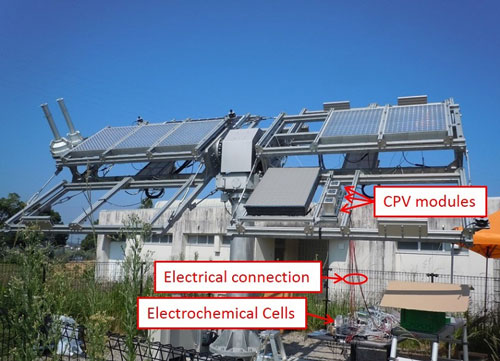| Sep 30, 2015 |
Highest efficiency hydrogen production under natural sunlight
|
|
(Nanowerk News)
Researchers at the University of Tokyo and Miyazaki University have produced hydrogen under natural sunlight at an energy conversion efficiency of 24.4%, the highest ever achieved, using high efficiency solar cells to power water electrolysis ("A 24.4% solar to hydrogen energy conversion efficiency by combining concentrator photovoltaic modules and electrochemical cells"). This is a significant step toward the substitution of fossil fuels with solar hydrogen.
|
 |
| High-efficiency hydrogen production under natural sunlight was demonstrated by connecting concentrator photovoltaic (CPV) modules, capable of high-efficiency solar electricity generation, with water electrolyzers with polymer membrane separators. The energy transfer efficiency from sunlight to hydrogen was maximized by optimizing the number of the CPV modules and the electrolyzers in series connection so that the system operation point was as close as possible to the maximum power point of the CPV modules. (Image: Masakazu Sugiyama, Katsushi Fujii and Kensuke Nishioka)
|
|
Increased demand for hydrogen as a clean fuel for vehicles and other applications is anticipated, but it is currently produced from fossil fuel. In order to increase Japan’s use of renewable energy at a substantial fraction in the total energy demand, it is vital to develop technologies for the high efficiency and low cost production of hydrogen using solar energy. Conventional approaches to solar hydrogen production using photocatalysts achieved a solar-to-hydrogen energy conversion efficiency of less than 10%, requiring improvements for real-world applications.
|
|
The research group of Associate Professor Masakazu Sugiyama and Project Professor Katsushi Fujii (Graduate School of Engineering, The University of Tokyo) and Associate Professor Kensuke Nishioka (Miyazaki University) used concentrator photovoltaic (CPV) modules, which includes a photovoltaic cell using a high-quality semiconductor crystal similar to the ones for lasers and LEDs operating under the focal point of an optical lens. The solar-to-electricity conversion efficiency of this CPV module is as high as 31%. The researchers also reduced energy loss by improving the connection between the CPV modules and electrolyzers, resulting in a solar-to-hydrogen energy conversion efficiency above 24%.
|
|
“The CPV modules and the electrolyzers used in this experiment are commercially available and it is possible to produce hydrogen under sunlight at a high efficiency with an appropriate system design for each installation,” says Associate Professor Sugiyama. He continues, “The CPV modules are comparatively expensive but if operated in countries with high solar irradiance it would be possible to generate solar electricity at low cost owing to the high energy conversion efficiency. In the near future, the cost of hydrogen produced by CPV modules and electrolyzes is expected to be below the target price of the United States Department of Energy of 4 US dollars per kilogram.”
|

